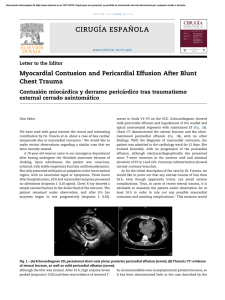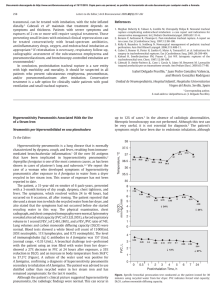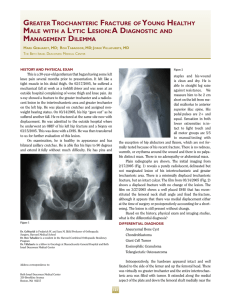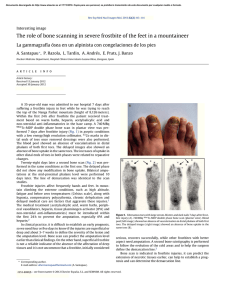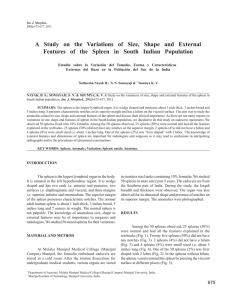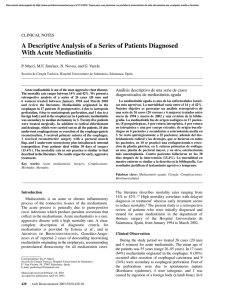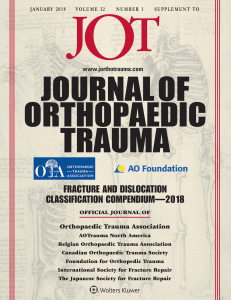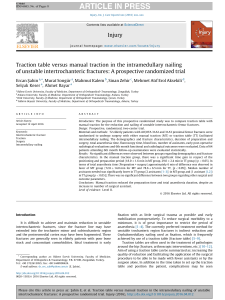Rugby Player With an ``Elephant`s Foot`` in the Chest
Anuncio
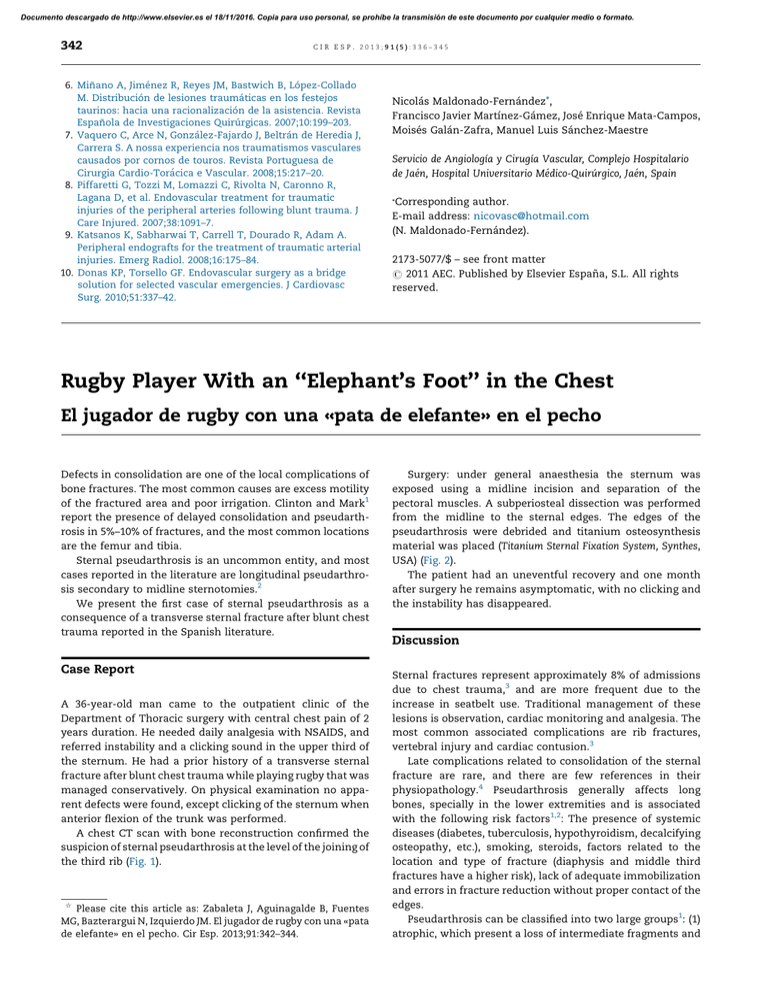
Documento descargado de http://www.elsevier.es el 18/11/2016. Copia para uso personal, se prohíbe la transmisión de este documento por cualquier medio o formato. 342 cir esp. 2013;91(5):336–345 6. Miñano A, Jiménez R, Reyes JM, Bastwich B, López-Collado M. Distribución de lesiones traumáticas en los festejos taurinos: hacia una racionalización de la asistencia. Revista Española de Investigaciones Quirúrgicas. 2007;10:199–203. 7. Vaquero C, Arce N, González-Fajardo J, Beltrán de Heredia J, Carrera S. A nossa experiencia nos traumatismos vasculares causados por cornos de touros. Revista Portuguesa de Cirurgia Cardio-Torácica e Vascular. 2008;15:217–20. 8. Piffaretti G, Tozzi M, Lomazzi C, Rivolta N, Caronno R, Lagana D, et al. Endovascular treatment for traumatic injuries of the peripheral arteries following blunt trauma. J Care Injured. 2007;38:1091–7. 9. Katsanos K, Sabharwai T, Carrell T, Dourado R, Adam A. Peripheral endografts for the treatment of traumatic arterial injuries. Emerg Radiol. 2008;16:175–84. 10. Donas KP, Torsello GF. Endovascular surgery as a bridge solution for selected vascular emergencies. J Cardiovasc Surg. 2010;51:337–42. Nicolás Maldonado-Fernández*, Francisco Javier Martı́nez-Gámez, José Enrique Mata-Campos, Moisés Galán-Zafra, Manuel Luis Sánchez-Maestre Servicio de Angiologı́a y Cirugı́a Vascular, Complejo Hospitalario de Jaén, Hospital Universitario Médico-Quirúrgico, Jaén, Spain *Corresponding author. E-mail address: [email protected] (N. Maldonado-Fernández). 2173-5077/$ – see front matter # 2011 AEC. Published by Elsevier España, S.L. All rights reserved. Rugby Player With an ‘‘Elephant’s Foot’’ in the Chest El jugador de rugby con una «pata de elefante» en el pecho Defects in consolidation are one of the local complications of bone fractures. The most common causes are excess motility of the fractured area and poor irrigation. Clinton and Mark1 report the presence of delayed consolidation and pseudarthrosis in 5%–10% of fractures, and the most common locations are the femur and tibia. Sternal pseudarthrosis is an uncommon entity, and most cases reported in the literature are longitudinal pseudarthrosis secondary to midline sternotomies.2 We present the first case of sternal pseudarthrosis as a consequence of a transverse sternal fracture after blunt chest trauma reported in the Spanish literature. Case Report A 36-year-old man came to the outpatient clinic of the Department of Thoracic surgery with central chest pain of 2 years duration. He needed daily analgesia with NSAIDS, and referred instability and a clicking sound in the upper third of the sternum. He had a prior history of a transverse sternal fracture after blunt chest trauma while playing rugby that was managed conservatively. On physical examination no apparent defects were found, except clicking of the sternum when anterior flexion of the trunk was performed. A chest CT scan with bone reconstruction confirmed the suspicion of sternal pseudarthrosis at the level of the joining of the third rib (Fig. 1). § Please cite this article as: Zabaleta J, Aguinagalde B, Fuentes MG, Bazterargui N, Izquierdo JM. El jugador de rugby con una «pata de elefante» en el pecho. Cir Esp. 2013;91:342–344. Surgery: under general anaesthesia the sternum was exposed using a midline incision and separation of the pectoral muscles. A subperiosteal dissection was performed from the midline to the sternal edges. The edges of the pseudarthrosis were debrided and titanium osteosynthesis material was placed (Titanium Sternal Fixation System, Synthes, USA) (Fig. 2). The patient had an uneventful recovery and one month after surgery he remains asymptomatic, with no clicking and the instability has disappeared. Discussion Sternal fractures represent approximately 8% of admissions due to chest trauma,3 and are more frequent due to the increase in seatbelt use. Traditional management of these lesions is observation, cardiac monitoring and analgesia. The most common associated complications are rib fractures, vertebral injury and cardiac contusion.3 Late complications related to consolidation of the sternal fracture are rare, and there are few references in their physiopathology.4 Pseudarthrosis generally affects long bones, specially in the lower extremities and is associated with the following risk factors1,2: The presence of systemic diseases (diabetes, tuberculosis, hypothyroidism, decalcifying osteopathy, etc.), smoking, steroids, factors related to the location and type of fracture (diaphysis and middle third fractures have a higher risk), lack of adequate immobilization and errors in fracture reduction without proper contact of the edges. Pseudarthrosis can be classified into two large groups1: (1) atrophic, which present a loss of intermediate fragments and Documento descargado de http://www.elsevier.es el 18/11/2016. Copia para uso personal, se prohíbe la transmisión de este documento por cualquier medio o formato. cir esp. 2013;91(5):336–345 343 Figure 1 – Chest CT with bone reconstruction where the arrows indicate the location of the pseudarthrosis in: (A) 3D reconstruction, (B) coronal reconstruction, (C) axial reconstruction, (D) sagittal reconstruction. substitution with scar tissue, related to poor vascularization and (2) hypertrophic, which are a consequence of a mechanical problem, such as excess mobilization. In colloquial terms, these last types are called ‘‘elephant’s foot’’ because of their radiological presentation, with an increase in bony fragments that appear at the edges of the callous. There are very few descriptions in the literature of sternal pseudarthrosis caused by chest trauma; therefore, to choose a corrective treatment, one must look at series of patients with sternal pseudarthrosis or non-union after midline sternotomies.5–7 Conservative treatment with teriparatide,8 ultrasounds2 or growth factors (bone morphogenetic proteins),9 has been used, although the most accepted treatment is fixation with osteosynthesis material.5,6,10 Several groups associate bone grafts6 or bone morphogenetic proteins4 to favour formation of new consolidation. We consider that posttraumatic sternal pseudarthrosis can be treated by correction of the cause and favouring the ossifying process, and we recommend an osteosynthesis with titanium material after debridement of the fracture edges. references Figure 2 – Intraoperative view of the osteosynthesis fixing the pseudarthrosis. 1. Clinton R, Mark B. The use of low-intensity ultrasound to accelerate the healing of fractures. J Bone Joint Surg Am. 2001;83:259. Documento descargado de http://www.elsevier.es el 18/11/2016. Copia para uso personal, se prohíbe la transmisión de este documento por cualquier medio o formato. 344 cir esp. 2013;91(5):336–345 2. Severson EP, Thompson CA, Resig SG, Swiontkowski MF. Transverse sternal nonunion, repair and revision: a case report and review of the literature. J Trauma. 2009;66:1485–8. 3. Potaris K, Gakidis J, Mihos P, Voutsinas V, Deligeorgis A, Petsinis V. Management of sternal fractures: 239 cases. Asian Cardiovasc Thorac Ann. 2002;10:145–9. 4. Morgan A. Treatment of chronic nonunion of a sternal fracture with bone morphogenetic protein. Ann Thorac Surg. 2008;85:e12–3. 5. Gallo DR, Lett ED, Conner WC. Surgical repair of a chronic traumatic sternal fracture. Ann Thorac Surg. 2006;81:726–8. 6. Bertin KC, Rice RS, Doty DB, Jones KW. Repair of transverse sternal nonunions using metal plates and autogenous bone graft. Ann Thorac Surg. 2002;73:1661–2. 7. Goy JJ, Poncioni L, Morin D. Chest pain due to severe sternal pseudoarthrosis post-coronary artery bypass surgery. Circulation. 2010;122:1134–5. 8. Chintamaneni S, Finzel K, Gruber BL. Successful treatment of sternal fracture nonunion with teriparatide. Osteoporosis Int. 2010;21:1059–63. 9. Cheng H, Jiang W, Phillips FM, Haydon RC, Peng Y, Zhou L, et al. Osteogenic activity of the fourteen types of human bone morphogenetic proteins (BMPs). J Bone Joint Surg Am. 2003;85:1544–52. 10. Wu LC, Renucci J, Song DH. Rigid-plate fixation for the treatment of sternal nonunion. J Thorac Cardiovasc Surg. 2004;128:623–4. Jon Zabaleta*, Borja Aguinagalde, Marta Gracia Fuentes, Nerea Bazterargui, José Miguel Izquierdo Servicio de Cirugı́a Torácica, Hospital Donostia, San Sebastián, Spain *Corresponding author. E-mail address: [email protected] (J. Zabaleta). 2173-5077/$ – see front matter # 2011 AEC. Published by Elsevier España, S.L. All rights reserved. Ectopic Spleen. Urgent or Elective Surgery? ? Bazo ectópico. Cirugı́a urgente o programada? Wandering spleen (WS) is an uncommon entity originated by a congenital or acquired laxity of the peritoneal ligaments, which causes an ectopic location of the spleen in the abdominal cavity. The first description of this clinical entity was reported by Van Horne in 1667 as an incidental finding in an autopsy. The real incidence of this problem is not known, but its rareness has been documented in a series of 1413 splenectomies where the incidence was 0.16%. It usually presents in middle aged adults and is more common in women in a proportion of 20:1.1 Symptoms are usually vague and non-specific, although in cases of torsion of the vascular pedicle it can present as an acute abdomen. This presentation is uncommon. We present two cases of wandering spleen, one an incidental finding and the other that presented as an acute abdomen. Case 1 A 30 year-old woman with no prior medical history was diagnosed of a pelvic mass in a routine gynecological exam. A CT scan of the abdomen identified a homogenous mass on top of the bladder with hilar vessels compatible with a wandering spleen; the vascular pedicle descended from the left upper quadrant (Fig. 1). Elective surgery was scheduled. A laparoscopic splenectomy was performed using a Hasson trocar for creation of the § Please cite this article as: Pérez-Legaz J, Moya Forcén P, Oller I, Arroyo A, Calpena R. Bazo ectópico. Cirugı́a urgente o programada? Cir Esp. 2013;91:344–345. pneumoperitoneum and two 10 mm trocars. The vascular pedicle was dissected with a white GIA and the spleen was removed through the umbilical trocar. The patient had an uneventful recovery and was discharged three days after surgery. Three weeks after surgery an antipneumococcal vaccination was administered. Case 2 A 25 year old woman with no prior medical history presented to the emergency department for abdominal pain located in the left upper quadrant and vomiting. On arrival she presented a temperature of 38 8C and on physical examination had diffuse abdominal pain with signs of peritoneal irritation. Blood tests revealed leukocytosis of 20.06103 ml 1, with neutrophils of 857% and fibrinogen of 10 g/l; all other parameters were normal. An abdominal CT scan revealed splenomegaly with no contrast uptake and a ‘‘whirl sign’’ at the vascular pedicle, indicative of torsion. A left subcostal laparotomy was performed that revealed an enlarged spleen with no ligament fixation that was free in the peritoneal cavity, and torsion of the vascular pedicle. After de-torsion the spleen remained ischemic and a splenectomy was performed. The patient had an uneventful postoperative recovery and was discharged 8 days later. Three weeks after surgery an antipneumococcal vaccination was administered. ?
